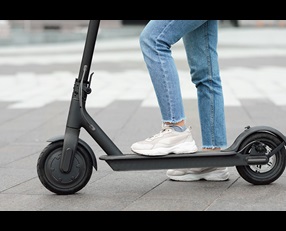2023 | Volume 24 | Issue 6

Surgeons were among trauma professionals who attended the Royal Australasian College of Surgeons (RACS) and Jamieson Trauma Institute 2023 Trauma Symposium in Queensland in November.
The event was part of RACS Trauma Week and aimed to tackle the issue of increased e-scooter injuries and deaths since the devices have gained popularity in recent years.
E-scooter injuries constitute five per cent of trauma admissions in Australia and this proportion is increasing, putting pressure on emergency departments and operating theatres.
Figures from the Queensland Injury Surveillance Unit capturing data from 20 emergency departments across the state showed e-scooter injuries had increased from 38 cases in 2018 to 1033 in 2022.
A similar rise has been experienced across the country, with Victorian doctors at two major hospitals reporting more than 500 patients presenting with e-scooter related injuries between January and October 2022.
Over the past five years, e-scooter injuries lodged with Aotearoa New Zealand’s Accident Compensation Commission have jumped from 674 to more than 2500 per year.
Queensland University of Technology and Jamieson Trauma Institute Trauma Surveillance and Data Analytics Chair Professor Kirsten Vallmuur said the trauma symposium brought together stakeholders from across the healthcare, regulatory, enforcement, and community sector to help tackle the problem.

She added, “The event provides the opportunity for stakeholders to hear each other’s perspectives and develop a better shared position around next steps to improve safety.”
Speakers shared insights and identified opportunities for strengthening safety to reduce the impact and severity of injuries related to the use of e-scooters and other forms of e-mobility.
These opportunities aligned with the position paper on Electric Mobility in Australia 2022 co-authored by Professor Vallmuur for RACS.
The position paper called for:
• greater provision of protected and connected infrastructure
• mandatory helmets
• single riders
• speed limits
• areas of designated riding and parking
• mandatory warning devices such as working bells and lights to alert pedestrians of their presence
• reduced drink-and drug-riding
• restrictions on mobile phone use when riding.
It also highlighted the need for a nationally recognised policy and regulatory framework and data recording, mandatory crash recording, and funding to support e-mobility safety.

In the lead up to the symposium, Queensland RACS Trauma Committee chair Dr Matthew Hope explained on ABC Brisbane why e-scooters had the potential to cause injuries that resulted in emergency department presentations.
“We know from data that's just come out from New Zealand and Australia, that the rate of injury on an e-scooter is somewhere between twice to 4.6 times the risk of an injury on a bicycle, so these things are significantly more dangerous than riding a bicycle, and that awareness really is what we're trying to get out to the public before they get on a scooter,” Dr Hope said.
“The problem is that they've got small wheels and your centre of gravity is high up, and when they come off the curb or hit something we’re seeing a lot of upper limb injuries, head injuries, and on our theatre list on Monday this week we had two patients with wrist fractures and one patient with an open ankle fracture that required surgery all morning.
“This was just in one hospital and we're seeing a steady rise since the beginning of these e-scooters in Brisbane in 2018,” Dr Hope said.
“We've had a steady increase and now we are seeing more patients with multiple traumas, certainly some data that's recently just come out from the Gold Coast shows that."
Dr Hope said he supported the introduction of more protected areas for bicycle and e-scooter users to help minimise injuries.
Auckland City Hospital Trauma, Acute Care and General Surgeon Dr Savitha Bhagvan said Aotearoa New Zealand had introduced rules that had improved rider safety.
“Effective methods to decrease injury have been to restrict the times of use (there is a ban on e-scooter use after 2am), restrict the speed of these scooters to 25km/h and geo-fencing where e-scooters automatically get disabled once they cross certain areas.
“The private e-scooters unfortunately are under no regulation, and they need to be brought under these restrictions too.”
Dr Bhagvan would also like to see the introduction of strict rules regarding the use of helmets, restricting the use of e-scooters to one rider at a time, a zero tolerance of alcohol when riding and a safer device design that lowered the centre of gravity, making it more stable.
The risk e-scooters pose to pedestrians, including people with impaired vision, was highlighted at the symposium by Vision Australia Lead Policy Advisor, Bruce Maguire.
“In 2018 Vision Australia commissioned research by Monash University to study the impact of electric and hybrid vehicles and bicycles on the safety of pedestrians who were blind to low vision,” Mr Maguire said.
“A key and alarming finding was that 35 per cent of respondents had been involved in a collision or near collision with an electric vehicle, and just as disturbing was the effect on people's mental and emotional wellbeing.
“Seventy five per cent said that the introduction of electric vehicle technologies had reduced their confidence to leave their houses, to walk around outside.”
A further study in 2021 revealed almost 40 per cent of respondents left their houses to walk on footpaths less often since the proliferation of electric vehicles.
Almost 90 per cent reported feeling less safe due to e-scooters and similar electric mobility devices.
Mr Maguire has called for the Australian government to introduce mandatory acoustic alerting systems in all electrical vehicles.
He would also like to see speed limits enforced, for the introduction of safe parking so the devices are not a tripping risk for those with vision impairment, and for riders to use separate lanes, rather than footpaths.
Brisbane City Highway Patrol Acting Sergeant Duncan Hill spoke at the symposium about the importance of education and enforcement in creating a safer environment.
“I was working in Brisbane City in 2018 at the time when all of a sudden, we had this brand new device. It just took off, but unfortunately with the popularity came people doing the wrong thing.”
He said that while many people rode e-scooters responsibly, more education was needed to ensure that riders understood the potential for harm and the road rules regarding speed, areas of safe use and helmet requirements.

“Often riders are travelling up to 60 kilometres an hour, commonly on roads or on footpaths, and that makes it dangerous for themselves and other road users. It also just adds an element of danger and risk to pedestrians using the footpaths.
“This is a new situation, where people aren't used to having to share with personal mobility devices, so when everything goes well, it goes well, but unfortunately when things go wrong because of the speed they're travelling at or the vulnerable nature of the pedestrian and the rider, they cause significant injuries.”
Police have been working with transport safety reference groups to provide advice and information about where road laws can change or be modified to ensure enforcement can be conducted more efficiently and effectively.
In November 2022, that resulted in an amendment to the road rules in Queensland reclassifying e-scooters as vehicles, rather than pedestrians. This changed where they could be ridden and treated the devices in the same way as bikes.
“That makes it easier for police to understand what the rules are and allows for greater consistency in the community and for riders about what the expectations are.”
Acting Sergeant Hill said that working with RACS and attending the symposium helped police understand injuries and focused their education and enforcement efforts.
“We share information and data that helps me conduct enforcement and education when I can see there is a spike in presentations in the Gold Coast, then I know that we need to do more work in that area.
“Or if there are kids getting injured, we can look at what we are doing in the space of young people riding these devices. It allows us the ability to target different areas and find better ways of preventing problems.
“We can also provide certain data to the different groups we work with, in relation to demographics —how many people are committing offences, the time of offences, and what age and gender they are—to help them build a profile for their studies.”
His message to e-scooter riders was to adapt to the conditions.
“Just because you're able to go 25 kilometres an hour on your device doesn't mean that you should be doing that speed. You need to look after yourself and the other road or footpath users. That’s the message we’re trying to get out there.”
With any kind of ban on devices unlikely, symposium attendees agreed to work to creating a safer environment for e-scooter riders and other road and footpath users.
The symposium provided a valuable insight into the current e-mobility regulatory, enforcement and injury position, which will provide the collaborative background for a revised RACS position statement on e-mobility.